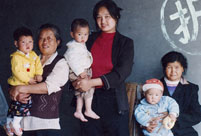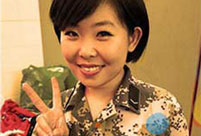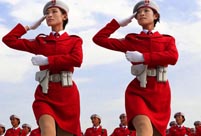 Close-up view of August Aerobatic Team
Close-up view of August Aerobatic Team
 Goddesses married in 2014
Goddesses married in 2014
 Polar region photos raise worldwide awareness of global warming
Polar region photos raise worldwide awareness of global warming
 Get off at the last stop — Beijing Subway in vision
Get off at the last stop — Beijing Subway in vision
 Top 100 beauties in the world!
Top 100 beauties in the world!
 Gallery: Who is the most beautiful one?
Gallery: Who is the most beautiful one?
 If you like autumn, put your hands in the air!
If you like autumn, put your hands in the air!
 Fan Bingbing's "Queen style" in new play
Fan Bingbing's "Queen style" in new play
 Lingerie show at 2014 Miss China
Lingerie show at 2014 Miss China
 J-10 fighters show aerobatic stunts in smog-free sky
J-10 fighters show aerobatic stunts in smog-free sky
Manufacturing
The manufacturing industry in Macao is dominated by the textile and garment sector. It is labour-intensive and export-oriented. Most of its products are exported to the United States of America and Europe.
The development of Macao’s manufacturing industry dates back to many decades ago, starting with firecrackers and incense. The textile and garment sector began to develop in the 1960s and entered its golden age in the 1970s and the 1980s. Meanwhile, companies manufacturing toys, electronics and artificial flowers also flourished. Entering the 1990s, the manufacturing industry slowed appreciably as Macao felt the impact of economic slowdown in its two major export markets – the United States of America and Europe, as well as rising domestic wages and competitive pricing from newly developing industrial countries.
On 17 October 2003, CEPA was signed in Macao and entered into force on 1 January 2004. Subsequently, 10 supplementary protocols to CEPA were signed during 2004 to 2013. The framework of CEPA offers facilitation in three areas of trade: goods, services and investments. Under CEPA, all Macao-originated goods that have established rules of origin are able to enjoy zero-tariff in mainland China since 1 January 2006, except for goods that are banned from entering the mainland or other restricted goods. As of the end 2013, Macao and mainland China have established rules of origin for 1,283 kinds of goods, fully covering Macao’s major export products. This provides an excellent incentive for local enterprises to enter the mainland market. Since 1 January 2014, measures relaxing such requirements in services trade in mainland China have totalled 383 and 10 categories of investments for Macao.
As the abolishing of export quota in international garment trade in 2005 posed a significant challenge to Macao’s manufacturing industry, the MSAR Government had proposed to the central government a plan to build a cross-border industrial zone between Macao and Zhuhai in order to combine the advantages of the two regions. The idea was approved by the State Council on 5 December 2003. The industrial zone sits on reclaimed land between the northwest coast of Macao and Zhuhai’s Gongbei district. Phase one of the project has a total area of 400,000 square metres. Some 290,000 square metres of this are in Zhuhai, and 110,000 square metres are in Macao. The Zhuhai-Macao Crossborder Industrial Zone and its round-the-clock customs checkpoint were inaugurated on 8 December 2006.
The signing of the framework agreement in Beijing on 6 March 2011 was important for Guangdong and Macao’s implementation of the Outline Plan for the Reform and Development of the Pearl River Delta, and the Mainland and Macao Closer Economic Partnership Arrangement, as well as the promotion of closer cooperation between the two regions. It marked a new phase of Guangdong-Macao cooperation. The 0.5-square-kilometre park is developed with a view to: consolidating the advantages enjoyed by Guangdong in terms of traditional Chinese medical science, education, scientific research and industry, and Macao’s technological competencies and human resources. On 19 April, an official launch ceremony was held for the Guangdong and Macao Traditional Chinese Medical Science and Technology Industrial Park.
The traditional manufacturing sectors are trying to adapt to the changing economic environment. Their contribution to Macao’s GDP is gradually decreasing, down from 10 percent in 1999 to less than 0.7 percent in 2012. Macao’s export value stood at 9.09 billion patacas during 2013,.up by 0.7 percent from the previous year. The value of re-exports was up by 21 percent year on year, while the export of local manufacturing industry was down by 12 percent. Hong Kong continued to be the major export market for Macao, with a share of 53.4 percent of Macao’s total export value, a year-on-year increase of 18.6 percent. Mainland China accounted for 17.7 percent of Macao’s total export value, a year-on-year increase of 17.3 percent. The United States accounted for 4.0 percent, a decrease of 28.1 percent.
 |  |
 20 years on: Relocated Three Gorges residents through lens
20 years on: Relocated Three Gorges residents through lens PLA HK Garrison veterans leave behind beautiful smiles
PLA HK Garrison veterans leave behind beautiful smiles Representative beauties of each province in China
Representative beauties of each province in China Chestnut girl goes viral online
Chestnut girl goes viral online Victoria's Secret Fashion Show
Victoria's Secret Fashion Show In photos: Bright and brave female soldier of PLA
In photos: Bright and brave female soldier of PLA China's charming first lady
China's charming first lady Excellent photos of Zhuhai Air Show
Excellent photos of Zhuhai Air Show China's heavyweight aircraft
China's heavyweight aircraft An old problem
An old problem Despite torture report, US escapes censure
Despite torture report, US escapes censure  Inflation hits five-year low
Inflation hits five-year low Runaway brides
Runaway bridesDay|Week|Month